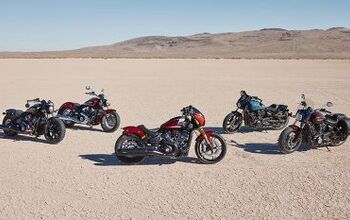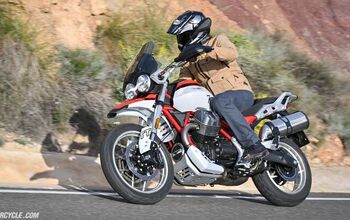Yamaha's Coming Out With a Race-Spec R1 In 2023

But there's a catch: It's only available in Europe. At least for now.
In a move further supporting my argument that R1s are purpose-built racebikes with lights and mirrors to make them legal on the roads, for 2023 Yamaha is introducing the R1 GYTR – an R1 prepared specifically for track duty, without any of the homologation pieces for roadworthiness (don’t worry, the standard R1 isn’t going anywhere). Yamaha similarly does the same thing with the R6, offering it for sale exclusively as a track-only model.
The catch? It’s only available in Europe.
Nonetheless, it’s worth talking about anyway, as a non-homologated motorcycle from a Japanese manufacturer is a big deal, and this model could eventually make its way to North America someday.
For the track enthusiast, the R1 GYTR (Genuine Yamaha Technology Racing) starts life as the basis for any track build. It takes the standard road bike, deletes the non-essentials, and leaves you with a blank canvas on which to modify. Except in Yamaha’s case, they go a step further and add on the bits you’re likely going to start buying anyway. The most noticeable change is the complete race bodywork finished in white, ready to accept your wildest (or mildest) livery design.
On the engine side, an Akrapovic race exhaust and mid-pipe replace the standard exhaust, and the ECU mapping is adjusted to account for the new air/fuel ratio. An engine cover set is also part of the deal and serves as a vital component to protect the case covers in the event of a crash.
Moving to the electronics side we see a GYTR ECU and wiring harness, PC interface cable to read the bike’s data, GYTR ABS Emulator, and a GYTR On/Off switch that replaces the stock ignition and key.
Less noticeable, but likely the most important, of the R1 GYTR’s changes comes in the chassis department. Specifically, the brakes. The rubber lines are gone, replaced with steel-braided pieces. Inside the caliper are GYTR steel pistons, and most importantly, the standard pads are replaced with Brembo’s Z04 pads for ultimate bite. Other bits include Bridgestone RS11 tires, a keyless fuel cap, different handlebars, steering stoppers, racing “Shark Fin” rear sprocket guard, a billet front brake lever guard, adjustable rearsets with reverse shift option, rear stand bungs, and a GYTR rear stand to put under those hooks.
Rounding out the changes is a gearing change, with a 15-tooth front sprocket and 42-tooth rear sprocket. The chain is now a 520 pitch instead of 530, reducing rotating mass for better acceleration.
GYTR Pro
If by this point you’re thinking those changes are nice but you need more, Yamaha’s got you covered with the new GYTR Pro line of accessories to further enhance the R1. As you can guess from the name, the Pro line of parts refines the R1 even more to make it an even sharper track machine. Here are just some of the components in the GYTR Pro lineup:
• GYTR PRO Swingarm
• GYTR PRO large capacity and low gravity fuel tank
• GTTR PRO Carbon rear subframe
• GYTR PRO Triple clamp
• GYTR PRO Carbon cowling set
• GYTR Pro screen
• GYTR PRO Dashboard
• GYTR PRO Dash support
• GYTR PRO Handlebars
• GYTR PRO Handle bar switches
• GYTR PRO Marelli electronics (customised)
• GYTR PRO Airducts for brake calipers
• GYTR PRO Brake lines
• GYTR PRO Brembo wheel adaptors (front and rear) to fit in the Öhlins FGR400 front forks and the inverted swingarm
• GYTR PRO Clutch
• GYTR PRO Side steering damper with bracket and clamp
• GYTR PRO MB radiator
• GYTR PRO Akrapovic system
• GYTR PRO Brake lever protector
While you can buy many similar parts for the R1 in the aftermarket, the beauty of GYTR parts is that they were designed by Yamaha, so there’s no questioning a parts compatibility.
Yamaha hasn’t stated definitively that the R1 GYTR or the GYTR Pro line of parts is a Europe-only special, but its press release was not distributed to US outlets. Nevertheless, if and when more information about the bike becomes available, we’ll post about it here.
Become a Motorcycle.com insider. Get the latest motorcycle news first by subscribing to our newsletter here.

Troy's been riding motorcycles and writing about them since 2006, getting his start at Rider Magazine. From there, he moved to Sport Rider Magazine before finally landing at Motorcycle.com in 2011. A lifelong gearhead who didn't fully immerse himself in motorcycles until his teenage years, Troy's interests have always been in technology, performance, and going fast. Naturally, racing was the perfect avenue to combine all three. Troy has been racing nearly as long as he's been riding and has competed at the AMA national level. He's also won multiple club races throughout the country, culminating in a Utah Sport Bike Association championship in 2011. He has been invited as a guest instructor for the Yamaha Champions Riding School, and when he's not out riding, he's either wrenching on bikes or watching MotoGP.
More by Troy Siahaan


























































Comments
Join the conversation
I'm not sure it would have required any special insight or knowledge to formulate your argument that R1's are built for the track since Yamaha told everyone that. Quoting directly from the Feb/March 2015 issue of Sport Rider Magazine about the new R1 (First Look-At Long Last), "A very important part of the development of this bike was the general development philosophy, and this was a HUGE (my emphasis) shift from in the past" says Yamaha Motor Corporation USA Product Planning Manager Derek Brooks. "In the past the primary focus has always been a really good bike for the road. Of course it's tested and developed on the racetrack as well, but the primary focus has been on the road, whereas with this bike, there was a fundamental shift and it was developed for the racetrack first and foremost."
Also, correct me if I'm wrong but the 2015+ R1's (even the R1S model) has always had steel braided brake lines on the fronts and a 525 chain not 530.
The irony is that these track bikes will probably actually run right, since the fueling will probably be sorted, something Yamaha either couldn't or refused to address with their "street" bikes they sold to the public. It takes a minimum of two grand to get it right!
I've owned 5 R1's, at one time had three, and currently have two-a 2003 from new and a 2016 and I can tell you the 2016 sucks on the road! It runs way too hot, gets lousy fuel mileage (I know it's a highly tuned liter sized sport bike, but still, I have a Mazda CX-5 with a 2.5 liter engine that gets the same mileage!), the throttle response is atrocious, and it's very uncomfortable. I'm maybe a little biased, but I happen to think the 03 R1 was the pinnacle of "pure street" liter bikes. My 16 is technically better in every way but out on the road, not really. There is basically nothing my 16 is better at than my 03, again, on the road. My 03 is the last of the long stroke motors, is comfortable for a sport bike, gets better mileage, runs way cooler, has some usable storage under the seat, and will out roll-on my 2016 up to about 125. The cross plane firing order does sound great though!
It's great that Yamaha will offer these track bikes to the well healed, but I'll say it again like I did in the MT-10 review: Please Yamaha put some bodywork on the MT-10 and sell us a gentleman's R1 for the street!
https://uploads.disquscdn.c...
Need to go back to calling it a "Git-kit".
(I'll "OK Boomer" myself...)